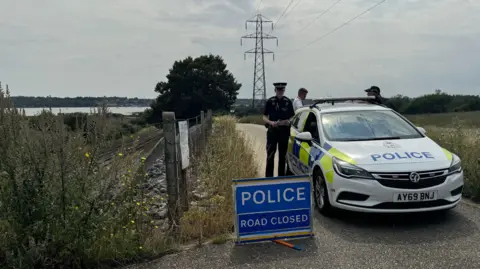'Oddball' murder accused is no killer - defence
 Crown Prosecution Service
Crown Prosecution ServiceA man accused of murdering a mother-of-six while she was walking her dog is an "oddball" but not a killer, according to his defence barrister.
Roy Barclay, 56, of no fixed address, is charged with the murder of Anita Rose, 57, who was attacked on 24 July 2024 in Brantham, Suffolk before dying four days later.
Mr Barclay, who denies killing the grandmother, has chosen not to offer any evidence or to be cross-examined during the course of the trial at Ipswich Crown Court.
In his closing speech, Simon Spence KC, who is representing Mr Barclay, told the jury they "can't find him guilty" unless they are certain he was the killer.
"There is no evidence at all of any contact between Roy Barclay and Anita Rose's body… contact there must have been if he was the killer," he said.
"He's innocent unless or until you, the jury, say otherwise."
 Suffolk Police
Suffolk PoliceMs Rose had been walking her dog Bruce along fields next to the railway line, sewage works and Stour estuary in Brantham early in the morning when she was attacked.
The grandmother of 13, who was found unconscious and with serious injuries, was taken to Addenbrooke's Hospital, in Cambridge, where she later died.
The prosecution said Mr Barclay murdered Ms Rose by stamping on her multiple times while wearing walking boots before fleeing the scene.
It is claimed he took Ms Rose's pink jacket, mobile phone and a key as "trophies of the killing".
But his defence barrister, Mr Spence, argued the defendant, who was homeless, may have found the possessions while "scavenging".
"If he was the killer obviously the thing to do is to get rid of them," he said.
"Would you keep those items or would you dispose of them as quickly as you could?
"And if he was the killer, [why did he keep his boots]? Why not just get rid of them? Chuck them in the river?"
 George King/BBC
George King/BBCHe was also caught on CCTV in Brantham at the time of the assault but Mr Spence said that "being in the vicinity of a crime means nothing".
"When you stand back objectively at the CCTV which puts Barclay on the 24 July in the Brantham area, what does it prove? We submit - nothing at all," he added.
"Is this of real significance, that he was in Brantham? It's one of the places he kept his clothing and possessions, a frequent visitor. [So], I suggest not."
Mr Spence said the absence of DNA weakened the prosecution's case and he was keen to stress to the jury that there was no sexual motive.
He also told the jury Mr Barclay was autistic, was unable to communicate verbally, and that his silence did not prove any guilt.
"Each strand there is doubt, it creates cumulative doubt, which you can't overlook," Mr Spence told the court.
The trial continues.
Follow Suffolk news on BBC Sounds, Facebook, Instagram and X.
